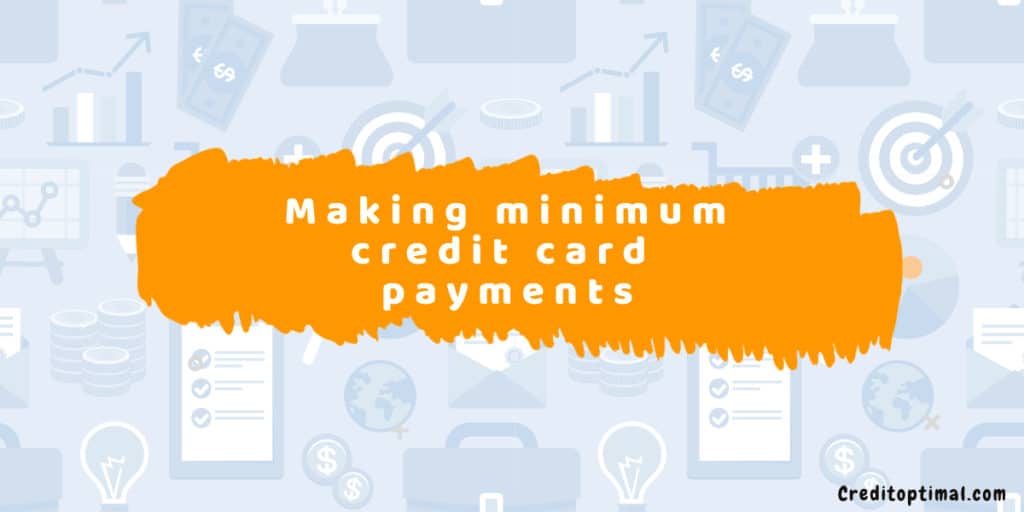Is Making minimum credit card payments a good idea? Let’s find out in this article.
When it comes to clearing credit card balances, it can be tempting to pay the bottom threshold of the amount due on your credit card bill.
Typically, there are three amounts you can pay when you receive your credit card bill: the current balance, statement balance, and minimum due. The minimum payment is the lowest threshold of the amount you can make to keep your account in good working condition. At the same time, the current balance is the cumulative balance of your latest bill with the addition of any new charges.
Statement balance, on the other hand, is the cumulative balance in your account for that specific billing cycle.
Financial experts recommend that you make all payments in full at the end of every month, but there are instances when your financial obligations wouldn’t allow you to complete the payments.
One of the top reasons you should avoid making minimum payments is the possibility of getting trapped in a debt cycle where you continually strive to hit the bottom threshold, which might make you adopt a habit of delinquency.
Even if you have resolved to stop using your credit card, making the minimum payment will lower the outstanding balance in the current month. However, continually making payment for this minimum amount would not reduce your outstanding amount.
This scenario may also increase your debt through the revolving credit facility provided by the credit card. In such a case, clearing the bottom threshold only, which is about 5% of the whole amount in the bill, would make you obligated to re-pay the outstanding amount to the loan issuer.
While there isn’t a fixed period to clear the payment – you can make any amount of payment at any time – the interest on the outstanding balance will get levied every day.
Credit card issuers have various approaches when making payments, but there are some fundamental concepts that you need to comprehend.
Methods of calculation
The bottom thresholds are calculated differently, but the most common minimum amount that you can pay is $25 or $35. If your statement balance is lower than this “floor,” however, your lowest payment will be this statement balance.
For instance, if the “floor” is $25, but your balance is $13.75, your minimum payment will be equal to this statement balance – $13.75.
Sum of finance charge and percentage of the balance
Some lenders calculate the bottom threshold for payment as a percentage of the balance before the billing period’s expiry and inclusion of a monthly finance charge.
For instance, if your balance is $2000, and your annual percentage rate is 20%, (APR) your minimum payment would be 1% – which translates to $20, as well as a finance charge of $25, which brings the total minimum amount to $45.
Percentage of the balance
Some credit card providers determine the minimum payment as a direct percentage of the balance at the expiry of your billing cycle.
This percentage could be slightly higher than the “sum of the finance charge and percentage balance” and would be applied to both the interest and principal amount.
Like the previous example, if you calculate the $2000 balance with a slightly higher rate than 1%, like 3 or 5%, the balance would be $40.
Other disparities
Several credit card issuers use the two methods highlighted above and determine the one that would yield the highest value.
In any case, either method can be merged with the “floor” amount, and if the sum yields a value less than $25 or $35, the “floor” amount will work instead.
Remember that penalty fees like delinquencies and past due amounts would be added to the calculation. Consequently, such additions would skyrocket your minimum payment significantly.
If you’ve exceeded your credit limit, your credit card issuer may also add that amount to your lower threshold payment.
For instance, if your credit limit is $2000, and you’ve exceeded it by a margin of $100, your minimum would be a sum of 2% of the total balance ($2100) – $42 – plus the exceeded amount ($100), which brings the full minimum payment to $142.
How to determine how your minimum payment is calculated
The most efficient way to learn how your minimum amount is calculated is by going through the credit card agreement. Take a close look at the “how your minimum payment is calculated,” or the section titled “making payments.”
If you have some challenges accessing this type of information, you can ask the customer representative to help.
How long it takes to complete the payment?
Credit card habitually set minimum payments at incredibly low levels.
Typically, you’ll owe the company a fixed amount – $25 or $35 – or a percentage of the balance, depending on the highest value.
Some cards would owe you only 1-2% of the balance at the end of every month as well as related interests and charges.
While making all these payments on time would save you from delinquencies, you would hardly make any progress with clearing off your debt.
According to the credit card act (2009), all issuers have a legal obligation to show a warning for the minimum payment on every billing statement. The company often represents the information in the form of a table displaying the cumulative time you’ll take to clear tour balance as well as the total amount you’ll end up paying, including taxes.
Paying only the minimum amount would put you in an endless circle of debt, and you’ll find yourself continually enslaved to the lender. This is because the first minimum payments would first clear interest, followed by fees, leaving only a small contribution to the principal amount.
If you analyze the payments carefully, you’ll notice that paying the minimum amount twice would reduce your repayment period by half.
Overall, exclusively making minimum payments would reduce you to a slave, and you’ll hardly make any progress toward clearing the principal amount.
Minimum payments are expensive
Throughout the period, your interest charges would rack up along your balances.
Making minimum payments only would make you run and run in a treadmill, and you’ll pay continually but never pay it off.
One significant challenge of credit cards is that card debt is typically higher than student loans or lines of credit loans.
So, making the minimum payment would pile interest, and you’ll hardly pay down your balance, resulting in double or triple payment of the original amount.
By the time you complete your last payment, you’ll realize how much time you’ve taken to clear the loan as well as the immensity of the margin above the total amount.
It could hurt your credit score
While there is a mammoth of factors determining your credit score, a significant amount relies on your payment history.
Most credit companies recommend a maximum credit utilization of 30%, but when your credit card balances shoot, your utilization spikes above this recommended percentage.
Since the credit card utilization ratio significantly accounts for a more significant percentage of your score, high balances could severely hurt your credit score.
Arguably, a long history of making payments on time may look enticing to your potential lender, but making minimum payments could spark some suspicion. The lender might choose to charge higher interest rates or refuse entirely to lend you the money.
In essence, what the lender can’t help to wonder is that if you can’t afford more than the minimum payment, the odds of clearing the rest of the loan could be daunting to you.
Beyond the apparent consequences of minimum payment – like expensive interest rates and low-quality loans – such behavior could take a toll on your mental health.
It becomes incredibly frustrating when you want to finance a new venture or buy a home with a loan, and every attempt seems to hit a brick wall due to a terrible credit score.
Scenarios when your minimum payment can be your full balance
If your balance is below or equal to the minimum payment, it automatically becomes the actual minimum amount.
Other scenarios include your account being charged off, and the credit card issuer demands full payment rather than monthly installments. Alternatively, if you have a charge card, your minimum amount becomes the total balance in your credit card, and you won’t be allowed to make monthly payments.
Reasons that could spike your minimum payments
The most unusual scenario that could increase your minimum amount is when your balance grows. Other causes include when you were late to make some payment, your interest rate increases, or you go above your credit limit.
If the credit card issuer alters the percentage used in the calculation – either because the company policy changed or you were a significant credit risk, the minimum payment would undoubtedly increase.
Conclusion – Making Minimum Credit Card Payments
It would be great if you make payments more than the minimum amount.
Clearing only the minimum amount would be the most expensive and not an excellent way to clear your credit card loan.
While there are situations that might force you only to pay the minimum payment, it would be wise if you avoid making it a long-term habit.
At the very least, make a slightly higher payment than the minimum only when something interrupts your cash flow.
Overall, reviewing your spending habits and ensuring a steady cash flow would be the ideal way to avoid minimum payments.


